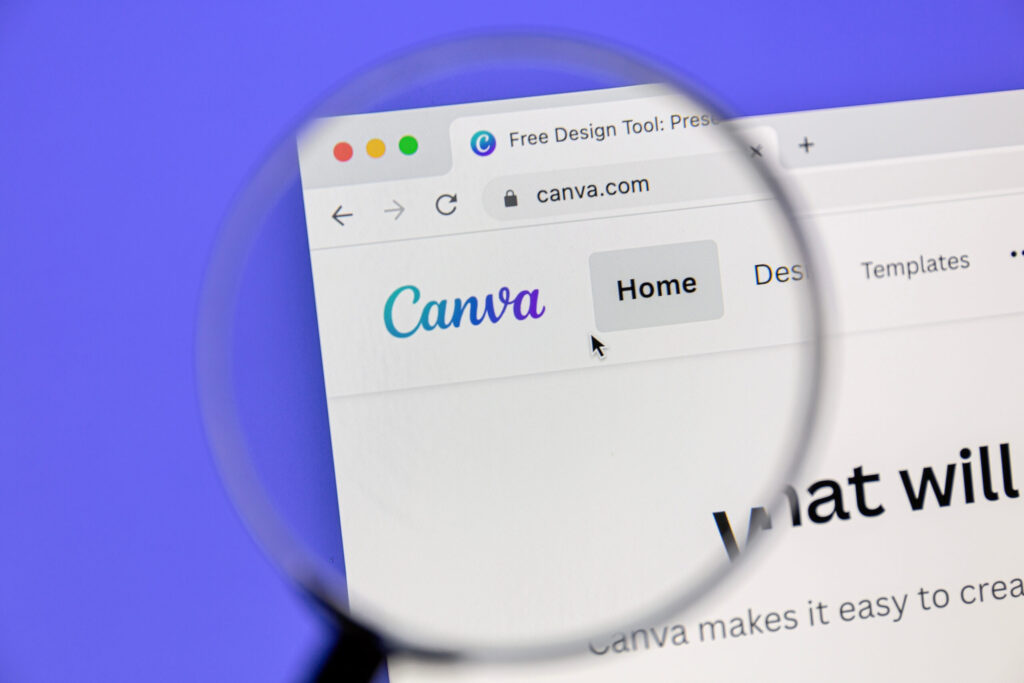Say hello to everything designed all at once—sales decks, social media posts, party invites, logos, brand assets, and more. Australia-based Canva, the seemingly ubiquitous web-based design platform, has wooed over 125 million people with an intuitive user interface—or UI—that makes it easy to design almost anything within its app. Canva is treating AI as a natural extension of its interface.
And now, after adding 40 million new users over just the last six months, the company has announced a momentous makeover of its platform. Canva introduced a colossal suite of new brand assets and generative AI-powered design tools as part of its Visual Worksuite, intended to help companies streamline their content creation efforts. Canva is the first company to integrate ChatGPT-style AI across its suite of products—making a convincing case for AI as a type of UI, part of CEO Melanie Perkins’ decade-long singular vision to make Canva operate as efficiently as possible.
There are now new ways to create custom presentations and image templates, automatically sync video footage to music, and translate words in designs into more than 100 different languages. Canva has added new tools that cater to marketing and creative organizations via a new “Brand Hub,” where companies can store style guides, quickly scale marketing assets, and even replace logos and images across all of a company’s designs.
“We’re infusing magic across the entirety of our products,” shared Perkins in an interview with Fast Company. “Magic” here is not just a sparkly descriptor but the word Canva uses to describe its new AI-infused suite of products. All the company’s new AI tools have the prefix “Magic.” The “Magic Eraser” can delete anything from an image, like people or errant objects. “Magic Edit” can replace an object with something else, and “Magic Design” selects personalized templates for any images you upload and can craft an entire presentation seemingly from the ether, including text and images. “Magic Write” generates text and a text-to-image feature the company says has been tested by a whopping 60 million users.
Most of these new features are designed to democratize creating content like presentations, social media graphics, and advertising materials that were not recently accessible to those without professional design experience or designers on staff.
Canva has positioned itself as a game-changer for individuals and Fortune 500 companies alike, including L’Oréal, Starbucks, FedEx, Zoom, and Salesforce, indicating that its design tools are increasingly the gold standard for large enterprises.
Canva is just one of several design-platform juggernauts rapidly rolling out new generative AI features. Adobe recently unveiled its Firefly platform, which features several new AI-driven tools; Microsoft introduced a new text-to-image generator for Bing and Edge, updates for AI image creator Midjourney, and more. Simply put, the AI sector is growing fast—according to a recent report by Pitchbook, the global market is expected to reach $42.6 billion in 2023.
All these innovations are leading to a brand-new era where anyone with a dollar and a dream can and will be able to create something. While the hype is huge, there are major concerns about the misuse of copyrighted materials and worries about potentially harmful misinformation that have brands and marketers wary of dancing into legal grey zones. Gartner research released in December 2022 found that 705 marketers surveyed feel that ethical AI will be a top concern by 2025. And professional designers and creatives are concerned that with the advent of these new tools, their expertise may become obsolete.
Job displacement is a fear for graphic designers as these new AI design tools proliferate. Will their jobs become automated, leaving them out of work? As generative AI takes off, designers worry that they will soon be replaced by computers that can create faster and more accurately than a human can match. Another concern is the threat of decreased creativity. As AI algorithms become better at generating designs, many fear that creativity will be stifled and forced to rely on a pre-existing machine-created templates and designs, which could lead to the homogenization of design, with an increasingly narrow range of templates and styles coming to dominate the visual ecosphere.
Perhaps somewhat surprisingly, Elon Musk, the billionaire bad boy entrepreneur and founder of Tesla, and the co-founder of OpenAI, the U.S. firm that developed the popular generative AI chatbot ChatGPT, has actually been one of the most vocal critics of AI, warning that one day it may pose a threat to humanity. Yikes. “One of the biggest risks to the future of civilization is AI,” Elon Musk shared with those attending the World Government Summit in Dubai, United Arab Emirates.
Is there anything designers can do to protect themselves from the potential pitfalls of AI?
The first thing is to stay ahead of the curve by keeping current on the latest AI developments to maintain skills and expertise.
Also, it may pay off to focus on developing a unique style and voice that is not easily replicable by machine. Think of incorporating hand-drawn sketches and illustrations in new and innovative ways.
Consider collaborating with developers and designers to craft designs that computers cannot make. Use the growing adoption of AI as an opportunity to be even more creative.
___________________________________________________
Bottomline
Generative AI offers exciting new opportunities for creativity and innovation, but questions abound about how exactly it will impact the lives of creatives. By staying ahead of the curve and embracing collaboration and retrenched creativity, you can help ensure that you are well-positioned to thrive in the age of AI.




